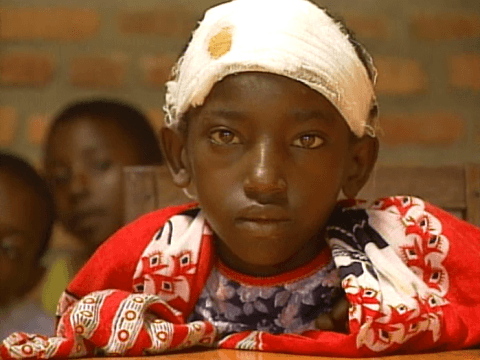Rwanda: Lessons still unlearned

Next Monday marks 20 years since the Rwanda genocide began. In 1994, John Schenk was one of the first Western journalists to go into Rwanda and show the full extent of the horrors of the genocide. His images appeared on national networks across North America and beyond. He currently works with World Vision managing the Communications Academy, where he teaches communicators from around the world how to tell the story of those in need.
We smelled the bodies before we saw them.
We approached on a dirt track muddy from two weeks of the rainy season. Trees and high shrubs obscured all but the tip of a roof, but a cross told us St. Francis Catholic Church at Karubamba was just around the corner.
We thought we were prepared. A Tutsi woman at a mission hospital a few miles back had told us about the massacre at the church. She described hundreds of people jammed into the sanctuary and surrounding buildings, praying Hutu death squads would not violate the refuge of the church.
But they did. The woman described guns fired through pried openings on the roof, grenades tearing bodies apart, including two of her own children, and machetes. These were the worst, simple but efficient farming tools hacking hundreds to death or into a daze where they could only lie still, bleed out and expire.
Despite her graphic account and the stench, my two colleagues, Scott Kelleher and Robby Muhumuza and I were unprepared for what lay around that corner.
Hundreds of corpses splayed across the earth in front of the church rotting in the rain for a week. More dead, layers deep, in small offices, and more again among broken pews in the sanctuary.
It was brutal. All we could do was revert to what had brought us there, taking pictures and shooting video.
Viewfinders and sense of purpose numbed us long enough to document what the world had not yet seen, despite the efforts of brave journalists in Kigali. They were working under constant threat from mobs. We were unhindered. The hundreds of dead here in one place spoke to the extent of the genocide transpiring inside Rwanda.
I put a large handkerchief over my nose and mouth, grabbed our Betacam and thought how I should set up the tripod. I ruled it out because all I wanted to do was get some shots and get out of that place as fast as possible.
A conversation began in my head. I recorded some tape. A voice said, “Done! Can we go now?” I answered, “No, we need more angles.”
I shot more angles. The voice said, “Good. Can we go now?” I replied, “No, the world has to see what happened here.”
I’ve no idea how long we stayed. We entered the church, peered into the offices and documented all we saw. My voices, the two sides of my conflicted self, only abated when we drove away.
It took two days to get back to Kampala, Uganda. Along the way we met Ugandan journalists who rescued survivors from a pit of bodies.
To hear John tell his story in his own words, click here.
Then, we flew to Nairobi, logged our images and shipped them to London by overnight courier. On Friday evening, April 29, 1994 the images comprised the lead story on the evening news on networks all over the world and played all weekend on CNN, the only 24/7 global news channel at that time.
The world responded.
April marks the 20th anniversary of this monstrous event, the 100-day slaughter of 800,000 human beings. How do we best commemorate it?
For me it was straightforward on the 10th anniversary. I returned to Rwanda, visited the church and met Mediatrice Mukarutaboro, the woman who in 1994 described to us the terrible events at St. Francis. She told me more of her story.
The mob murdered Mediatrice’s husband when he stepped out to reason with them. One of their grenades decapitated one of her children and gashed her scalp. Looking back, she said she was sure she was about to die.
Yet she chose to open her Bible to Psalms and read aloud, to bless neighbours and friends. Then she collapsed and lay among the dead for three days. She was discovered barely alive by a burial crew.
Mediatrice and others showed me Rwanda was forgiving, healing and prospering. Reconciliation programs were working. The dead were being honoured.
So, how do we do the same on the 20th anniversary? I believe we look elsewhere.
Rwanda is sorting itself out. It has not been easy. It is not over but accomplishments are admirable. Let’s look to the other Rwandas, Central Africa Republic, Darfur, Democratic Republic of the Congo, South Sudan, Syria and others.
We shot film and videotape 20 years ago and it was four days before they reached TV screens. Today a satellite modem is the size of a laptop and digital images go live in minutes. Journalists are risking their lives to expose today’s horrors and aid workers risking theirs to provide assistance.
The world condemns the current horrors but most of them have been dragging on for years. None have been stopped. Millions have died. The misery is immeasurable. It is almost a relief to ponder watching ceremonies marking Rwanda’s genocide. It is post holocaust and largely a success story.
But what comes after the ceremonies? Which reality do we then face, the other Rwandas or who gets kicked off the island this week?
In the real world lives are at stake. We cannot plead ignorance and we aren’t just following orders. It’s Nuremburg. We have both front row seats and we are in the witness stand. Our humanity is on trial.
“Can we go now?”

